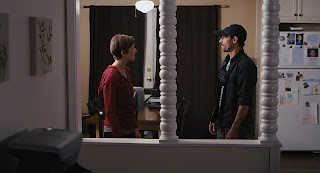Movie Review - The Paper Tigers
Alain Uy (Helstrom and True Detective) stars as Danny, which has to be a reference to the protagonist in The Karate Kid who was also named Danny. However, like Cobra Kai, we don't start with Danny as a teenager. We start with him possibly in his late 40's or early 50's. He works as an insurance agent or works in the insurance industry in some capacity. He's not wealthy or makes all that much money. He drives a beat-up minivan. He's divorced or separated from his wife, but he has a son who is maybe 7 or 8. He's not that great a father. He loves his son and wants to be there for him. Unfortunately, he's not always able to be there. In that sense, he's not only like Danny but he's also like Johnny Lawrence from Cobra Kai too. Yet, this film doesn't deliver fully either in the sympathetic or even empowering way as just those initial two episodes of Cobra Kai.
Ron Yuan (Mulan and Marco Polo) co-stars as Hing, a friend of Danny who most likely went to the same school as him as children and through high school. What bonded them is that he and Danny along with a third guy were students for a martial arts teacher who they called Sifu Cheung. It's not sure how they met Sifu Cheung and came to be his students. From home videos from 1986, it seems as if they trained in the garage of Sifu Cheung. Hing and the other two were set to go to Japan to participate in some competition, but about 30 years later, Hing has lost touch with Danny and the other student. He's fallen out of shape and is chubby. That might have stemmed from the fact that he injured his leg a decade ago, so now he has a limp. He'd worked odd jobs though until then.Mykel Shannon Jenkins (The Rich & the Ruthless and The Bold and the Beautiful) also co-stars as Jim, the aforementioned, other student who trained under Sifu Cheung. Unlike Danny and Hing, Jim isn't Asian. He's instead African-American. Again, we don't learn how he came to be a student for Sifu Cheung. He stopped speaking to Danny because Danny backed away from the competition. Danny basically forfeit the game, which upset Jim. The film doesn't really put a lot of meat on the bones of their falling out. It just seems to be a lame way to keep the three guys who were nicknamed "Three Tigers" apart from each other, so that the inciting incident can occur.
That inciting incident is the death of Sifu Cheung. Some unknown figure kills Sifu Cheung in the alley behind the restaurant that Sifu Cheung either owns or where he works. This film is basically then a murder mystery built around the three fight sequences. Yet, if Danny, Hing or Jim had kept in touch not just with each other but also with Sifu Cheung for the better part of a decade or more, then that would render the mystery and the first, two fight sequences moot or pointless. I'm not saying that one thing shouldn't lead into another. I'm saying that the Three Tigers' estrangement from Sifu Cheung was not properly explained or felt. Yes, one has to suspend disbelief to accept most film premises, but the film is better when it helps the audience to understand or feel those premises in a deeper or profound way. This film merely says the Three Tigers were estranged from each other and Sifu Cheung for 15 years and no other explanation is provided.Matthew Page (Enter the Dojo) plays Carter, a rival martial arts student who would fight Danny and seemingly lose. He wasn't a bully or seemingly a bad kid. He's a white guy who took the martial arts and Chinese culture very seriously. Yet, he wasn't as regarded in school as the Three Tigers. Now, decades later, he's running a martial arts school under Sifu Wong. His rigidity about martial arts and Chinese culture, which could be seen as cultural appropriation, is a source of comedy in this film, which despite being a murder mystery is a more comedic film overall. Page is a scene-stealer who injects humor into this film that helps to buoy it.
A lot of the humor comes from the fight scenes. The joke is that the Three Tigers aren't in their prime. They're older guys and can't fight like they used to fight. They can't run without getting tired. They can't do kicks or certain moves without pulling muscles. They're not as sharp or as fierce. Unfortunately, this film really fails to delve into the personal lives of Hing and Jim, but when it comes to Danny, we see several scenes between Danny and his son. Danny says he doesn't want to raise his son thinking that fighting or violence is the solution to problems. I like that aspect of the film, but I'm not sure the film lands this theme by the end. The film could've had Danny struggling with the idea of not wanting to fight or use violence in order to solve problems, but in each of the scenes where he does fight, there is no struggle. He readily does so, despite what he tries to teach his son.Rated PG-13 for some strong language, offensive slurs, and violence.
Running Time: 1 hr. and 50 mins.
Available on VOD.














As an upgrade over the original PP sheets, China Bopp film suppliers films have attained biaxial polymeric alignment, which preserves the polymer's protective qualities while claiming enhanced optical transparency. This feature is both functional and aesthetically pleasing, enabling the layout to take incredible leaps forward with the addition of visual arts and improved packaging.
ReplyDelete